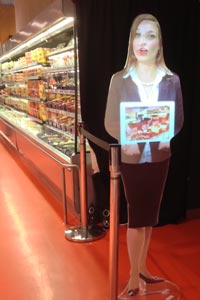
I have no idea what The Body Artist is about. Instead, let me tell you about grocery shopping in my neighbourhood. One of the places I go to buy my food is the Loblaws in Maple Leaf Gardens, former home of the Toronto Maple Leafs where they won the Stanley Cup in 1967 (and never again). When you walk through the front door, you’re greeted by a well-spoken woman offering cooking tips or hawking wares or something. To be honest, I breeze past her and so have no idea what she says. She isn’t a woman, of course. She’s a Plexiglas frame in the shape of a woman. Behind the frame is a projector shining the image of a woman onto the Plexiglas frame. It reminds me of Disney World animatronics. Every time I step into the store, I expect to see a pirate singing Yo, Ho, Ho, and a bottle of rum! Arrrrrgh. If you burrow further into the store, you’ll find a man doing the same thing. He offers tips on how to barbecue the perfect steak or some other stereotypically gendered version of culinary masculinity.
What happens when customers get tired of the spiel? Presumably Loblaws can plug in a new chat about the wonders of spinach or sausages or whatever. It doesn’t have to be the same models either. Anybody will do. Project it onto the same Plexiglas form: the generic, all-purpose, perfectly proportioned, reusable, disposable, consumable human body.

I wonder if that’s sort of what The Body Artist is about: if you allow commerce to sink to the very foundation of your life, your culture, your values, your ways of seeing, then it’s inevitable that your own body will become subject to its machinery. Its machinery, from Gutenberg to Henry Ford, is the efficiency of the mass produced commodity for sale in the (unregulated) marketplace.
Lauren Hartke is the body artist. She works at developing a perfect control of her body, choreographing performance art. She is recently widowed. She thought her husband was just going out on a routine errand; instead, he drove to his first wife’s home and shot himself in the head. Now, Hartke rattles around in a big rented house. However, she isn’t alone. There’s an older man in the house. The man isn’t exactly a stalker. But he isn’t exactly not a stalker either. One might say that he’s not one thing or another in his own right. He and Hartke have odd Aspergerish conversations. It’s not apparent that he has a distinctive intelligence or personality.
The man startles Hartke by speaking with the voice of her late husband. At first she thinks it’s simple mimicry. Her husband used to record messages on a dictaphone. Maybe the old man used it to learn the voice. However, it becomes apparent that the old man is doing something more than mimicry; he is her husband’s voice. He speaks to her beyond embodiment. Even beyond time.
He hasn’t learned the language. There has to be an imaginary point, a nonplace where language intersects with our perceptions of time and space, and he is a stranger at this crossing, without words or bearings.
The mention of nonplace reminds me of observations from Geoff Dyer and Pico Iyer about the condition of life in our new global consciousness. Airports and hotels are a kind of nonplace which exists outside of space and time. Why should we not apply this same consciousness to our bodies. The old man “violates the limits of the human.”
Near the end of the book, we read a report, a review of a performance called Body Time which Hartke stages at the Boston Center for the Arts. In preparation, she had altered her body. “She is not pale-skinned so much as colorless, bloodless and ageless.” Over the course of the performance, she progresses through a series of bodies. “The last of her bodies, the naked man, is stripped of recognizable language and culture.” The reporter observes:
The power of the piece is Hartke’s body. At times she makes femaleness so mysterious and strong that it encompasses both sexes and a number of nameless states. In the past she has inhabited the bodies of adolescents, Pentecostal preachers, a one-hundred-and-twenty-year-old woman sustained by yogurt and, most memorably, a pregnant man. Her art … is about who we are when we are not rehearsing who we are.
The next logical step is to abandon the body altogether. Leave it to digital recordings projected onto the backside of Plexiglas forms. Leave it to Disney animatronics. One day, we may encounter these beings and not know the difference. Or care.